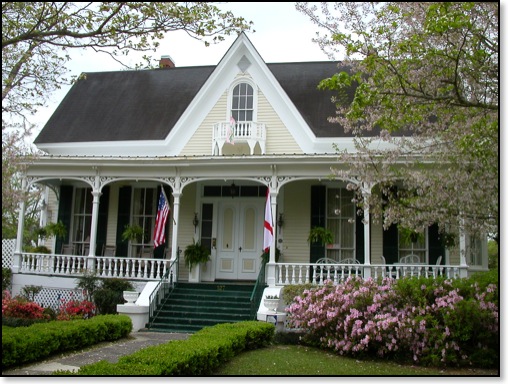
The Petry-Honan
Home
The Petry–Honan home was has been a “Tour of Homes” favorite since it was first featured in the 1974 Eufaula Pilgrimage. The home has a number of unique features that make it very popular:
- The Petry-Honan home,
built circa 1868, home has been occupied by the
Petry-Stewart-Honan family since 1876. This is far longer
than any other home on the Eufaula Pilgrimage Tour of
Homes. Having the same family in the home for over 130
years has resulted in a treasure trove of antique
furnishings, clothing and documents being preserved in
the home.
- The Petry-Honan home is the only home in Eufaula that still has its original detached kitchen intact.
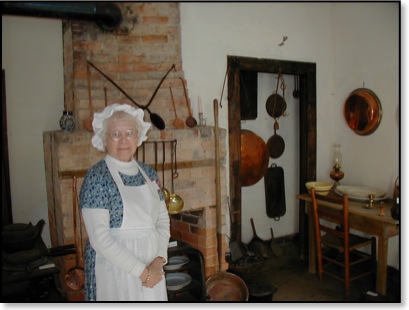
“The Old Kitchen”
- The Petry-Honan home,
with its one of a kind “tank room” under the eaves, was
one of the first--if not the first--home in Eufaula, to
have running water.
- The Petry-Honan Home is the only home on the tour in which all of the Hosts and Hostesses wear period clothing. It creates a special atmosphere that the Pilgrims really enjoy.
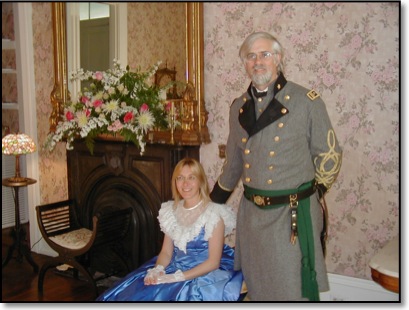
Anmarie and Terry Honan welcome Pilgrims in their period
attire.
- Cannon Firing: Major Edward White started the family tradition of cannon firing. Major White served as an officer in Lafayette’s Light Infantry during the American Revolution. He made it a rule and duty to celebrate, with his neighbors, all the battles of the Revolution that he had fought in. He had a four-pounder cannon on his plantation near Milledgeville, Georgia which he used to fire the salute on such occasions. Whenever the cannon fired, it was a signal and invitation to neighbors to come celebrate, eat barbecue and drink rum. The Honan’s continues the tradition with Terry’s four-pounder cannon which is fired at the Petry-Honan Home during the pilgrimage by a group of War Between the States reenactors.
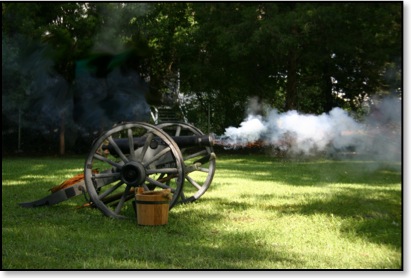
Firing the Four-pounder
Cannon
No other private home on the
tour has the extensive collection of Barbour County and
Eufaula family history that you find in the Petry-Honan
home:
- Terry Honan’s family
settled in Barbour County in 1818, the year before
Alabama became a state.
- Terry’s Great 4th -
grandfather, Edmond Hobdy, served on the first county
commission of Pike County in 1821, which included part of
what is now Barbour County.
- Edmond’s son and
Terry’s Great 3rd - grandfather, Harrell Hobdy, was
Barbour County’s first sheriff in 1833.
- The last Indian battle
in this area, the Battle of Hobdy Bridge, occurred on the
Hobdy Plantation in 1837.
- Harrell Hobdy’s
father-in-law, John McNeill, Terry’s Great 4th -
grandfather, in 1820 became the first white man to die in
what is now Barbour County.
- In 1840, Terry’s
Gr-Gr-grandfather, N. Montross Hyatt, settled in
Irwinton, the town that in 1842 changed its name to
Eufaula. Judge N. Montross Hyatt, Eufaula’s first
silversmith and long time justice of the peace, served on
the City of Eufaula’s first city council.
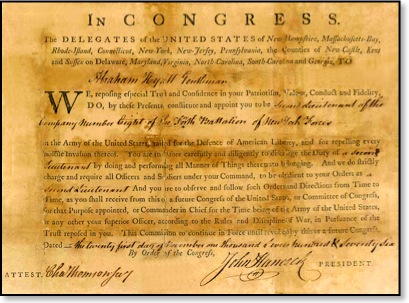
Terry’s Gr-4th-grandfather’s,
Abraham Hyatt’s, Revolutionary War Commission Signed by
John Hancock.
The Petry-Honan home will be open:
Friday, April 4, 2008, 9:00 AM – 5:00 PM
Saturday, April 5, 2008, 9:00 AM – 5:00 PM
Sunday, April 6, 2008, 1:00 PM – 5 PM